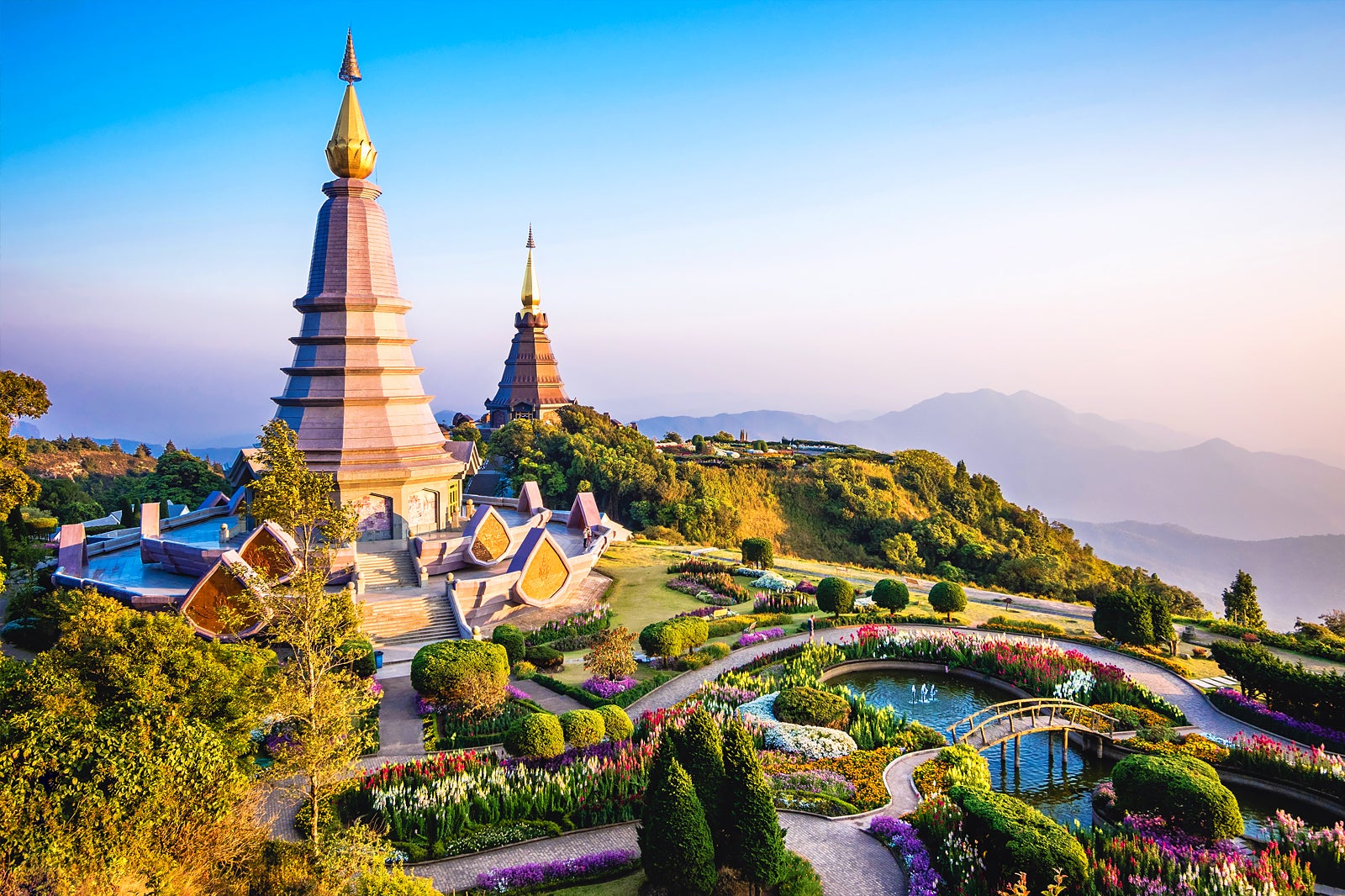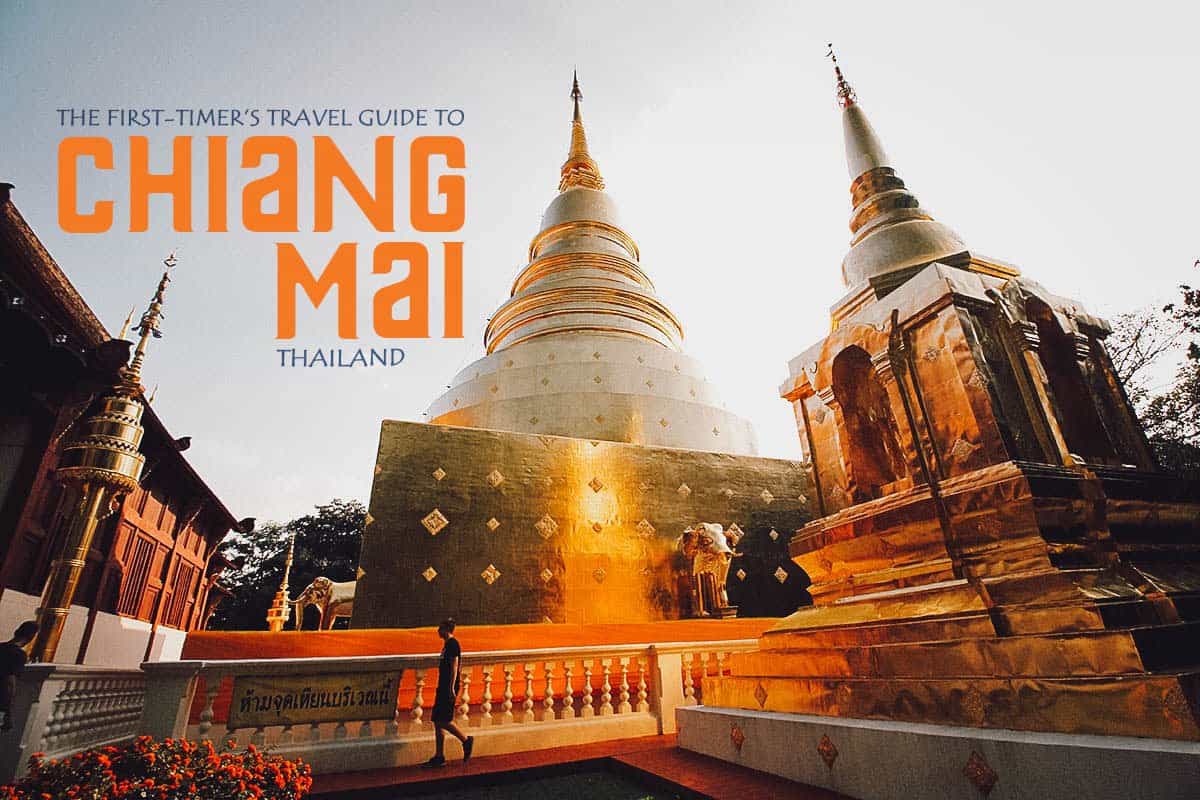
Nestled amidst emerald mountains and ancient temples, Chiang Mai, the "Rose of the North," beckons travelers with its unique blend of cultural richness, natural beauty, and a laid-back charm that contrasts with the frenetic energy of Thailand’s capital. More than just a tourist destination, Chiang Mai is a living, breathing testament to a bygone era, a place where tradition gracefully intertwines with modernity. Whether you’re seeking spiritual enlightenment, adventurous escapades, or simply a taste of authentic Thai life, this captivating city offers an unforgettable journey.
A Tapestry of History: Echoes of the Lanna Kingdom
Chiang Mai’s story is deeply rooted in the powerful Lanna Kingdom, founded in 1296 by King Mangrai. For centuries, it served as the capital of this independent kingdom, fostering a distinct cultural identity that is still palpable today. The city’s strategic location, nestled along the Ping River, made it a vital center for trade and a hub of Buddhist art and architecture.

Related Articles about Chiang Mai: A Journey to the Rose of the North:
- Seoul: A City Where Ancient Majesty Meets Futuristic Flair
- A Traveler’s Guide to Surabaya: Discovering the Soul of Indonesia’s City of Heroes
- The Concrete Jungle Where Dreams Are Made Of: Your Ultimate Travel Guide to New York City
- Emerald Isle Enchantment: Unveiling Ireland’s Top Attractions and Essential Travel Guide
- Qatar: A Jewel of the Arabian Peninsula – Your Ultimate Travel Guide
Over time, Chiang Mai experienced periods of Burmese rule and later became a vassal state of Siam (now Thailand). Despite these shifts in power, the Lanna spirit persisted, leaving an indelible mark on the city’s traditions, language, and, most importantly, its magnificent temples. Today, exploring Chiang Mai is like stepping back in time, with ancient moats, crumbling walls, and glittering wats whispering tales of its glorious past.
Unveiling Chiang Mai’s Treasures: Top Attractions
Chiang Mai’s allure lies in its diverse attractions, catering to every kind of traveler. Here are some of the absolute must-sees:
-
Wat Phra That Doi Suthep: Perched atop a mountain overlooking the city, this is arguably Chiang Mai’s most iconic landmark. A golden stupa houses a relic of the Buddha, making it a sacred pilgrimage site. The Naga-lined staircase leading up to the temple is an experience in itself, offering breathtaking panoramic views as you ascend. Don’t miss the intricate murals and the serene atmosphere.
-
Old City Temples: The heart of Chiang Mai beats within its ancient walls. The Old City is a labyrinth of narrow lanes dotted with over 300 temples. Key highlights include:

- Wat Chedi Luang: Once home to the Emerald Buddha, this imposing temple features a massive, partially ruined chedi that stands as a testament to the city’s historical grandeur.
- Wat Phra Singh: Known for its beautiful Lanna-style architecture and a revered image of the Buddha, this temple is a vibrant center of religious activity.
- Wat Phan Tao: This unique temple is constructed entirely of teak wood, offering a glimpse into traditional Lanna craftsmanship.
- Wat Chiang Man: The oldest temple in Chiang Mai, it houses two ancient Buddha images, Phra Sila and Phra Leang, believed to have brought rain.
-
Doi Inthanon National Park: Known as Thailand’s "roof," Doi Inthanon is home to the country’s highest peak. The park boasts stunning natural beauty, including cascading waterfalls like Mae Ya and Wachirathan, lush forests, and the majestic twin pagodas of King Bhumibol and Queen Sirikit, offering incredible views. Hiking trails cater to various fitness levels, and the cool mountain air is a welcome respite from the city’s heat.
-
Elephant Sanctuaries: A responsible way to interact with these magnificent creatures is crucial. Opt for ethical sanctuaries that prioritize elephant welfare, offering opportunities to feed, bathe, and observe them in their natural habitat without riding. Research reputable sanctuaries that focus on rescue and rehabilitation.
-
Night Bazaar and Weekend Walking Streets: As dusk settles, Chiang Mai transforms into a shopper’s paradise. The Night Bazaar is a bustling hub of stalls selling everything from handicrafts and clothing to souvenirs and street food. The Saturday and Sunday Walking Streets (Wua Lai and Thapae respectively) are even more expansive, showcasing local artisans and offering a vibrant cultural experience with street performers and delicious food vendors.
-
Thai Cooking Classes: Immerse yourself in the flavors of Thailand by taking a cooking class. Learn to prepare classic dishes like Pad Thai, Green Curry, and Mango Sticky Rice from skilled local chefs. It’s a fun, interactive, and delicious way to experience the culture.
-
Hill Tribe Villages: While requiring a guided tour, visiting nearby hill tribe villages offers insight into the diverse ethnic groups that inhabit the region, such as the Hmong and Karen. It’s important to approach these visits with respect and sensitivity, ensuring your presence benefits the communities.
Navigating Your Journey: Travel Tips for Chiang Mai
To make your Chiang Mai adventure smooth and enjoyable, keep these practical tips in mind:
- Visa Requirements: Most nationalities receive a visa exemption for short stays in Thailand. However, it’s always advisable to check the latest visa regulations with the Thai embassy or consulate in your country before your trip.
- Currency: The Thai Baht (THB) is the official currency. ATMs are widely available, and credit cards are accepted in most hotels, restaurants, and larger shops.
- Language: The official language is Thai. While English is spoken in tourist areas, learning a few basic Thai phrases like "Sawasdee ka/krub" (hello) and "Khob khun ka/krub" (thank you) will be greatly appreciated.
- Etiquette: Thailand is a Buddhist country, so dress modestly when visiting temples, covering your shoulders and knees. Remove your shoes before entering temples and private homes. Avoid touching people on the head, as it’s considered the most sacred part of the body.
- Health and Safety: Consult your doctor about recommended vaccinations before traveling. Drink bottled water and be mindful of street food hygiene. Chiang Mai is generally a safe city, but always be aware of your surroundings and take precautions against petty theft.
- Bargaining: Bargaining is expected in markets and with tuk-tuk drivers, but always do so with a smile and a respectful attitude.
- Connectivity: Wi-Fi is readily available in hotels, cafes, and restaurants. Purchasing a local SIM card is also an affordable option for staying connected.
Finding Your Home Away From Home: Accommodation Options
Chiang Mai offers a diverse range of accommodation to suit every budget and travel style:
- Luxury Hotels: Indulge in world-class amenities, stunning city views, and impeccable service at luxury hotels located in the city center or in tranquil areas outside the Old City.
- Boutique Guesthouses: For a more intimate and personalized experience, opt for charming boutique guesthouses within the Old City. These often boast unique designs and a warm, welcoming atmosphere.
- Mid-Range Hotels: Numerous comfortable and well-equipped mid-range hotels are available throughout Chiang Mai, offering a good balance of comfort and affordability.
- Budget Hostels: Backpackers and budget travelers will find a plethora of clean and social hostels, perfect for meeting fellow travelers and saving money. Many offer private rooms as well.
- Serviced Apartments and Villas: For longer stays or families, serviced apartments and villas provide more space, privacy, and self-catering facilities.
- Unique Stays: Consider staying in a traditional teak house or a serene riverside resort for a truly immersive experience.
When choosing your accommodation, consider your priorities. Staying within the Old City offers easy access to many attractions and a vibrant atmosphere. If you prefer a quieter escape, look for options slightly outside the city walls, often with beautiful natural surroundings.
Getting Around Chiang Mai: Transportation Options
Navigating Chiang Mai is an adventure in itself, with various transportation options available:
- Songthaews (Red Trucks): These are the most common and affordable mode of transport. They operate like shared taxis, picking up and dropping off passengers along fixed routes. You can hail them from the roadside, and the fare is usually agreed upon before or at the end of the journey.
- Tuk-Tuks: A quintessential Thai experience, tuk-tuks are a fun way to explore the city, especially for shorter distances. Always negotiate the fare before getting in.
- Grab (Ride-Hailing App): Similar to Uber, Grab is a convenient and reliable option for booking private cars or motorbike taxis. It offers fixed prices and is a good alternative to haggling with traditional taxis.
- Motorbike Taxis: For solo travelers and quick hops, motorbike taxis are readily available. They are fast but require caution due to traffic.
- Bicycles: Renting a bicycle is a fantastic way to explore the Old City at your own pace, allowing you to discover hidden alleys and charming courtyards.
- Walking: The Old City is highly walkable, and strolling through its streets is a rewarding way to soak in the atmosphere and discover its hidden gems.
- Car Rental: If you plan on venturing beyond Chiang Mai for extended day trips, renting a car can offer flexibility. However, be prepared for local driving customs and parking challenges in the city.
The Perfect Time to Unveil the Rose of the North: Best Time to Visit
Chiang Mai experiences a tropical climate with three distinct seasons, each offering a unique charm:
-
Cool/Dry Season (November to February): This is widely considered the best time to visit Chiang Mai. The weather is pleasantly cool and dry, with average temperatures ranging from 15°C to 25°C. The skies are clear, making it ideal for outdoor activities, temple exploration, and enjoying the beautiful scenery. This is also the peak tourist season, so expect larger crowds and higher prices.
-
Hot Season (March to May): Temperatures soar during this period, with highs often exceeding 30°C and humidity increasing. While still manageable, outdoor activities might be more challenging during the midday heat. However, this season offers fewer crowds and potentially better deals on accommodation.
-
Rainy Season (June to October): This season brings refreshing rain showers, which help to cool down the landscape and bring it to life with lush greenery. While there can be heavy downpours, they are often short-lived and occur in the afternoon or evening, leaving the mornings and evenings pleasant. The rain also means fewer tourists and lower prices. The landscapes are at their most vibrant during this time.
A Note on Festivals: Chiang Mai hosts several vibrant festivals throughout the year. Yi Peng (Lantern Festival) and Loy Krathong (typically falling in November) are particularly magical, with the sky illuminated by thousands of floating lanterns and krathongs. The Songkran Festival (Thai New Year in April) is a nationwide water fight, a truly exhilarating and unforgettable experience.
Beyond the City Limits: Day Trips and Excursions
Chiang Mai serves as an excellent base for exploring the surrounding region:
- Mae Rim Valley: Discover beautiful botanical gardens, the Queen Sirikit Botanic Garden, and various waterfalls.
- Chiang Rai: A longer day trip or an overnight stay to visit the iconic White Temple (Wat Rong Khun) and the Black House (Baan Dam).
- Pai: A bohemian mountain town known for its relaxed vibe, stunning landscapes, and hot springs.
- Sukhothai Historical Park: A UNESCO World Heritage site, offering a glimpse into Thailand’s first kingdom.
The Enduring Appeal of Chiang Mai
Chiang Mai is more than just a destination; it’s an experience that lingers long after you’ve left. It’s the scent of incense wafting from ancient temples, the gentle smile of the locals, the vibrant colors of the markets, and the serene beauty of the surrounding mountains. Whether you’re a seasoned traveler or embarking on your first Southeast Asian adventure, Chiang Mai promises a journey filled with discovery, cultural immersion, and an enduring sense of peace. So pack your bags, open your mind, and prepare to be enchanted by the Rose of the North.





